Roller skating is an exhilarating activity that has captivated the hearts of millions around the world. If you are an enthusiast who dreams of creating your very own roller skating rink, one vital aspect cannot be overlooked—the skating floor.
In this guide on how to build a roller skating rink floor, we will go through the essential considerations, materials, and techniques involved in constructing a floor that will set the stage for countless hours of excitement and entertainment. Let’s get rolling!
Page Contents
Detailed Steps to Build a Roller Skating Rink Floor
Step 1: What to Prepare
- Location: Choose a flat and smooth location—don’t forget to consider factors such as space availability, accessibility, and zoning regulations. Two ideal areas for making a rink are the garage and driveway.
- Blueprints: Plan the layout of your roller skating rink, considering factors such as the size of the space, the number of skaters you expect to accommodate, and any specific features or areas you want to incorporate. You will need a tape measure for this.
- Materials & Tools: Gather the necessary materials and tools for the construction, such as plywood sheets, subflooring, flooring materials, screws, nails, adhesives, a saw, a drill, measuring tools, and safety equipment.
Step 2: Prepare the subfloor
- Clear the area of any debris or obstructions so the surface is clean, level, and dry.
- Outline the areas you want to turn into a skating rink. It should measure at least 20’x20′ or 8’x16′ to serve its purpose well.
- Install a moisture barrier, such as a vapor barrier or a plastic sheet, to protect the floor from moisture seeping up from below. This is particularly important if you build the floor outside.
- Lay down a layer of ¼-inch plywood sheets as the subfloor. Ensure the sheets are tightly secured using screws or nails.
- Make any necessary adjustments to the subfloor, such as filling in gaps or sanding down uneven areas.
Step 3: Install the skating surface
- Choose the appropriate flooring material for your roller skating rink. A popular option is laminate flooring.
- Follow the manufacturer’s instructions to install the chosen flooring material, ensuring a smooth and level surface throughout.
- Pay attention to maintaining a consistent level throughout the surface to avoid any uneven spots that could disrupt the skating experience.
- Secure the flooring using recommended adhesives, screws, or nails. As there’s the plywood subfloor underneath, make sure the fastening nails/screws are long enough to pierce through the layers.
- Test that the flooring is properly installed and secure before moving on to the next steps.
- Walk or skate across the entire surface, paying attention to any areas that feel loose or unstable. Make any necessary adjustments or repairs to ensure that the flooring is secure and provides a solid skating experience
Step 4: Finishing touches
- Trim the edges of the flooring material, ensuring a neat and professional appearance.
- Install any additional features or amenities you desire, such as handrails, seating areas, or portable decorations.
- Consider adding roller rink floor patterns to enhance your skating rink’s visual appeal.
Step 5: Safety measures
- Install protective padding or barriers to enhance safety and prevent injuries.
- Ensure proper lighting and ventilation to create a comfortable skating environment.
DIY Roller Skating Rink Ideas
1. Converting a garage
Converting a garage into a roller skating rink provides a convenient space for skating year-round, protected from weather conditions. The indoor structure offers privacy and allows for customization options, such as lighting, decor, and sound systems.
However, garage spaces might have limited dimensions, requiring careful plans. The existing concrete or uneven flooring may need to be leveled, which can add to the overall cost of the project.
2. Converting a basement
Basements offer the advantage of ample space, allowing for a larger roller skating rink compared to a garage. The enclosed nature of basements provides privacy, and the existing concrete or solid flooring usually means you don’t have to level the floor.
But basements often lack proper ventilation and natural lighting, which may need to be addressed through additional installations. Moisture and humidity can also pose problems in the long run.
3. Converting a parking lot, driveway, or backyard
These areas provide an outdoor skating experience with ample space for larger rinks and the possibility of hosting events. The existing pavement can serve as a skating surface, minimizing material costs.
However, backyard roller skating rinks are subject to weather conditions and may not be suitable for year-round use in certain climates. The surface of parking lots or driveways might not be smooth or even, so you may need costly repairs to level the surface.
Frequently Asked Questions
How big should a roller rink be?
The size of a roller rink can vary depending on construction details, such as the intended capacity, layout design, and available space. But a home rink is usually 20’x20’ or 8’x16’.
Roller skating floor tiles, what type of floor is best for roller skating?
Maple hardwood flooring is widely considered the best type of flooring for roller skating rinks. They provide a balance of grip and glide, allowing skaters to maintain control while still experiencing a smooth skating surface. They are also durable, resistant to moisture, and easy to clean and maintain.
How long does it take to build a roller skating rink?
The timeline can vary depending on various factors, such as the size of the project, the complexity of the design, available resources, and any necessary permits or inspections.
For home projects, you can reliably expect the skating rink to be ready for use within one to two hours.
What permits or regulations are required to build a roller skating rink?
Permits and regulations can vary depending on your location. It is crucial to research and comply with local zoning and building codes. Contacting your local municipal or building department can provide information on the necessary permits, inspections, and any specific requirements for constructing a roller skating rink.
Conclusion
Building a roller skating rink is an exciting endeavor that allows you to create a space where joy, laughter, and thrilling skating experiences can come to life.
Throughout this guide on how to build a roller skating rink floor, we have explored the essential steps and considerations involved in constructing your dream roller skating rink.
Now, armed with the necessary knowledge, you are ready to embark on your roller skating rink journey.

Harrison is a skating enthusiast who picked up the sport during her student exchange years in Canada. She has been a skating coach for children and teens for 3 years and now holds classes as a freelancer. Harrison entwines her experience leading skating classes in the content published on Cora to help readers fall in love with skating, just like she did.

















